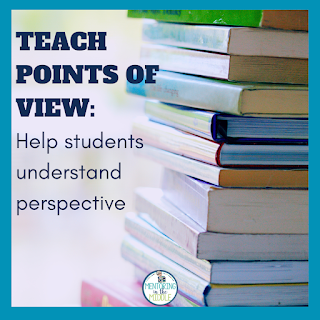One of my favorite activities to do when teaching point of view, is to have students take the book they're reading and rewrite a section from a different point of view.
That works really well when students get a good perspective of the reasons why authors write from different points of view. And that takes a little bit of working through!
It can be a lot of fun to discuss perspectives in books and watch your students think about the differences between first-person, second-person, third-person limited, and third-person omniscient, and then explore why an author might have written from that point of view.Let's Get Started
Start with the basics. Make sure students know (and by know, I mean write down) the meanings of each point of view. In my district, we only taught first-person and general third-person point of view in 6th grade, but I would recommend these four.
- First-person: One of the characters tells the story. The reader may or may not know what other characters are thinking or feeling. The reader is "inside the head" of the person telling the story. Commonly used words: I, me, mine, my, us, our, ours
- Second-person: Not frequently used in fiction although there are some examples. Second-person puts the reader into the story, almost like you are taking a tour of the book. You are treated as part of the action. Commonly used words: you, your, yours
- Third-person Omniscient: The narrator can reveal the thoughts and feelings of all the characters in the story. The narrator knows what's happened to characters in the past, what they are feeling, and maybe even what will happen in the future.
- Third-person Limited: The narrator reveals the thoughts and feelings of only one character but only has information for the scene that is being read at the time. Commonly used words: he, she, they, their, it, him, her, them
Point of View: beginning activities
Start with something easy like this. Watch the video Glued and have students discuss how the video would have been different if it had been told from the boy's point of view.
Are you reading a book aloud to your students? Put them into small groups and have them determine the point of view of the book. Have them take a scene and describe how it would have played out differently if it was told from another perspective.
Students read 67 different sentences and determine the point of view. Then they color in the picture according to the directions. Best for those who have learned all the points of view.
Point of View: examples in books
Here are some examples of books told from various points of view. If you have enough books, set them out at tables in random groups, and have students figure out which point of view they're told from. If you only have a few, read a passage from each and let students determine the perspective.
First-person: Zlata's Diary by Zlata Filipovic; Wonder by R.J. Palacio (told from several 1st-person points of view); The Hunger Games by Suzanne Collins; Towers Falling by Jewell Parker Rhodes; The True Confessions of Charlotte Doyle by Avi; Out of My Mind by Sharon Draper; House Arrest by K.A. Holt.
Second person: Goodbye Stranger by Rebecca Stead tells the story from two perspectives, of which one is 2nd-person; Choose Your Own Adventures; and the You Wouldn't Want to be series.
Third-person omniscient: From the Mixed-Up Files of Mrs. Basil E. Frankweiler by E.L. Konigsburg: The Lion, the Witch and the Wardrobe by C.S. Lewis; The Ranger's Apprentice series by John Flanagan.
Third-person limited: The Giver by Lois Lowry; Harry Potter series by J.K. Rowling; A Wrinkle in Time by Madeleine L'Engle; Refugee by Alan Gratz; The Only Road by Alexandra Diaz; Lines of Courage by Jennifer Nielsen.
Students read 67 different sentences and determine the point of view. Then they color in the picture according to the directions. Best for those who have learned all the points of view.





No comments
Post a Comment